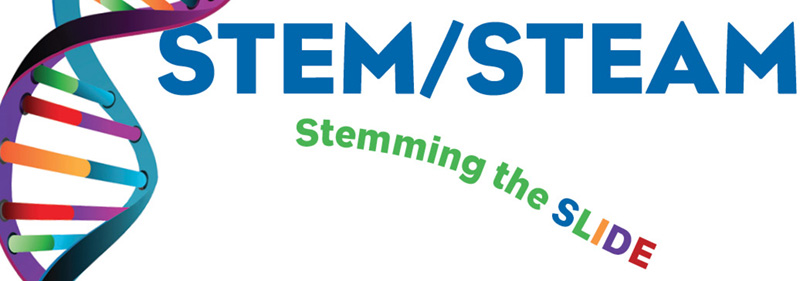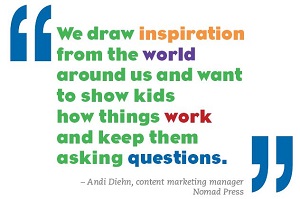STEM/STEAM: Stemming the Slide
With the world in the grip of a deadly pandemic that has raised more questions than scientists can answer, it is more imperative than ever that young children pursue STEM/STEAM fields. Building children’s confidence to ask questions, make guesses, think creatively, and reach for knowledge in subjects typically regarded as “too hard” is critical.


In the nearly 20 years since it was coined by Dr. Judith Ramaley at the National Science Foundation, the STEM acronym (science, technology, engineering, and math) has become a regular part of the education world’s vocabulary. And STEM schools have been cropping up across the country, according to a 2019 article in the Public School Review. But the need that spurred the creation of STEM and also STEAM education—to better prepare students for the jobs of the future—is more acute than ever.
STEM fields are still challenged by a shortage of new talent, despite the headway schools have made integrating STEM into the curricula. The perceived difficulty of STEM subjects is cited as the main reason students don’t pursue these fields, according to a Pew Research Center 2018 survey. Regardless of subject matter, students around the country have an even greater challenge returning to school this fall, following a spring of educational disruption. And educators have a tough road ahead to keep them engaged and motivated, to prevent the backsliding known as the “COVID Slide.”
 Reading materials that inspire, spark imaginations, and prompt children to ask “Wow, how does that work?” are critical to engaging, growing and expanding young minds. From a children’s biography about Marie Curie, who overcame enormous hurdles in her research on radioactivity and went on to win two Nobel Prizes, to a book that explores how birds have adapted to use their own spit as a building material for nests, the fall’s new STEM/STEAM titles will motivate and delight children in any learning environment, virtual or real.
Reading materials that inspire, spark imaginations, and prompt children to ask “Wow, how does that work?” are critical to engaging, growing and expanding young minds. From a children’s biography about Marie Curie, who overcame enormous hurdles in her research on radioactivity and went on to win two Nobel Prizes, to a book that explores how birds have adapted to use their own spit as a building material for nests, the fall’s new STEM/STEAM titles will motivate and delight children in any learning environment, virtual or real.
National Geographic Kids Books
The National Geographic Society has long had a deep connection with STEM and a focus on the discovery side of science. Thanks to the organization’s 132-year history as a pioneer and chronicler of scientific exploration, the National Geographic Kids team has access to many of the world’s greatest scientific minds, as well as to the top-notch photography that has earned the publications their reputation. National Geographic Kids strives to engender a sense of wonder and curiosity through its publishing lineup.

Solve This! Forensics: Super Science and Curious Capers for the Daring Detective in You, March 2020, ISBN 9781426337444, by Kate Messner and Anne Ruppert, gets readers ages 8–12 excited about forensic science by offering six cases for kids to solve themselves. This title goes beyond the basics of fingerprints and shares the science behind things like break patterns, plant DNA, and the ways forensics teams identify people at a crime scene. By applying what they’ve learned, young readers can put together clues and solve each case.
In Beastly Bionics: Rad Robots, Brilliant Biomimicry, and Incredible Inventions Inspired by Nature, June 2020, ISBN 9781426336737, author Jennifer Swanson takes readers ages 10–14 through animal biomimicry and shares how technological innovations are often inspired by natural phenomena. By studying the intuitive and cognitive abilities of bottlenose dolphins, for example, scientists are gaining a better understanding of how to detect tsunamis. Swanson also describes how the protective red liquid that oozes from the skin of hippos is yielding insights that will help develop better sunscreens.
In “Explorer Academy,” a fact-based fiction series for middle grade readers, young explorer Cruz Coronado lives and travels aboard a world-roaming classroom-at-sea. Together with his international pals, Cruz races to solve different mysteries and uses his cryptology knowledge to crack complex codes. In Explorer Academy: Tiger’s Nest, January 2021, ISBN 9781426338625, by Trudi Trueit, Cruz faces a foe on an island nation in the Indian Ocean who aims to stop him from putting together the pieces of his most pressing mission: cracking a cipher left behind by his deceased mother.
Author Melissa Stewart brings readers ages 8–12 the “gross” factor with Ick: Delightfully Disgusting Animal Dinners, Dwellings, and Defenses, June 2020, ISBN 9781426337468. From the filthy environs of the dung beetle to the panda mother who eats her baby’s poo, this photography-rich title is as educational as it is gag-inducing, and helps kids realize that what’s disgusting to us is often necessary for an animal’s survival.
Brain Games: Colossal Book of Cranium Crushers, May 2020, ISBN 9781426336751, by Stephanie Warren Drimmer and Dr. Gareth Moore, captures the spirit of the National Geographic TV show Brain Games in full-color, activity-book format. Brain teasers like mazes, sudoku, and riddles are broken down for readers ages 8–12, with neuroscience-based explanations of how their brains are being tricked as they solve the puzzles.
Nomad Press
STEM books are an important part of the lineup of this 20-year-old publisher that focuses on “bringing learning to life” while promoting independent and interactive learning.
“We draw inspiration from the world around us and want to show kids how things work and keep them asking questions,” says Nomad’s content marketing manager, Andi Diehn. “A roller coaster, for example—is it the seatbelt keeping a person in their seat, or is there more to it?”

“Adaptations,” by Laura Perdew and illustrated by Katie Mazeika, is a set of five books in the “Picture Book Science” series that covers bizarre aspects of scientific adaptation among animals. Spit Nests, Puke Power, and Other Brilliant Bird Adaptations, August 2020, ISBN 9781619309524, explains how some birds use their spit to build nests, while others defend themselves with vomit. Each book includes hands-on activities, a glossary, and a poem for language arts connection. For readers ages 5–9.
For readers ages 12–15, the “Human Science” set (part of the “Inquire & Investigate” series) includes three books that delve into what makes us tick as human beings while explaining critical advancements in STEM. The Human Genome: Mapping the Blueprint of Human Life, August 2020, ISBN 9781619309074, by Carla Mooney and illustrated by Tom Casteel, for example, defines the basic terms of genomics and goes on to explain how scientists have learned to map genomes to aid with vaccines and disease cures.
 The “Science Biographies” set, part of the “Build It” series, details the inspiring lives of STEM greats Marie Curie, Benjamin Franklin, and Leonardo da Vinci. The Science and Technology of Marie Curie, May 2021, ISBN 9781647410223, by Julie Knutson and illustrated by Michelle Simpson, explains the struggles Curie faced in what was once exclusively a man’s field. Despite these obstacles, Curie went on to win not just one but two Nobel Prizes for her work in chemistry and physics.
The “Science Biographies” set, part of the “Build It” series, details the inspiring lives of STEM greats Marie Curie, Benjamin Franklin, and Leonardo da Vinci. The Science and Technology of Marie Curie, May 2021, ISBN 9781647410223, by Julie Knutson and illustrated by Michelle Simpson, explains the struggles Curie faced in what was once exclusively a man’s field. Despite these obstacles, Curie went on to win not just one but two Nobel Prizes for her work in chemistry and physics.
Lerner Publishing Group
This 60-year-old publisher has always had a strong nonfiction focus, with a heavy emphasis on STEM titles for K–12 readers. Its books typically include two or more of the STEM subjects, working in concert with one another. Lerner also embeds plenty of interactive and hands-on activities in its titles, to help young readers apply what they’ve learned.
The Great Bear Rescue: Saving the Gobi Bears, September 2020, ISBN 9781541581258, by former science teacher Sandra Markle, highlights the fragility of the animal kingdom. After realizing that just 22 Gobi bears were left in the world, scientists used GPS collars to track the bears’ habits and behaviors, to understand what was threatening the species’ survival. What they found was a critically endangered population of herbivorous bears imperiled by sparse vegetation and illegal gold miners, who inadvertently poisoned the bears’ water supply. Photography and maps give fourth through sixth graders a sense of these bears’ natural environment as they learn what scientists are doing to save them.
Genomics: A Revolution in Health and Disease Recovery, September 2020, ISBN 9781541500563, by Whitney Stewart and Hans C. Andersson, M.D., lets sixth through twelfth graders see the practical applications of genomics. One man, for example, never found relief from his celiac disease through conventional treatments. Thanks to genomics, doctors were able to isolate the specific genetic mutation causing his autoimmune disorder, leading to potentially better, more targeted treatments.
 In Bionic Beasts: Saving Animal Lives with Artificial Flippers, Legs, and Beaks, October 2020, ISBN 9781541589407, author Jolene Gutiérrez highlights the remarkable cases of different “bionic” animals for fourth through eighth graders. Lola, for example, is a Kemp’s ridley sea turtle whose injured flipper was amputated. Thanks to a group of college students, she now has a new flipper made from 3-D–printed silicone. Suggested activities for readers include projects like building a movable hand from straw and string.
In Bionic Beasts: Saving Animal Lives with Artificial Flippers, Legs, and Beaks, October 2020, ISBN 9781541589407, author Jolene Gutiérrez highlights the remarkable cases of different “bionic” animals for fourth through eighth graders. Lola, for example, is a Kemp’s ridley sea turtle whose injured flipper was amputated. Thanks to a group of college students, she now has a new flipper made from 3-D–printed silicone. Suggested activities for readers include projects like building a movable hand from straw and string.
In Girl Code Revolution: Profiles and Projects to Inspire Coders, November 2020, ISBN 9781541596726, author Sheela Preuitt gives third through sixth graders an overview of the history of women coders, prompting them to try coding, too. Preuitt includes profiles and quotes from women like Ada Lovelace, who worked in the 1800s on the world’s first computer, and Lindsey Scott, the founder of coding nonprofit Girls Who Code. Readers are invited to visit the digital “sandbox” via vidcode, where they can create basic animations, memes, and more.
Flowerpot Press
Flowerpot Press started in 2005 as a collaboration between brother and sister Patrick and Anne Hayes. Despite the company’s rapid growth, it remains very much a family business today. Flowerpot’s focus has always been on publishing brightly illustrated books for very young readers. The company’s catalog emphasizes early learning concepts and STEM/STEAM titles that encourage children to ask questions, wonder, and build hypotheses about the world around them.
The “How Do” series features seven books for readers ages 7–12 that are based on the premise that children’s innate curiosity goes well beyond the subjects they are learning in school. These nonfiction books provide a great introduction to various STEM subjects through a Q-and-A format that offers one silly answer and one serious one, so readers can simultaneously laugh and form educated guesses about the topic at hand. Each title includes facts and figures, diagrams, and wonderfully funny illustrations.
For How Do You Stop a Moving Train?, September 2020, ISBN 9781486718627, self-professed “science nerds” Lucy D. Hayes and Madeline J. Hayes—Patrick’s daughters—teamed up with illustrator Srimalie Bassani to help young readers understand the basic concepts of physics. Prompting readers to form a hypothesis with a question like “How do you think an airplane flies?” the book then explains forces like thrust, friction, gravity, propulsion, and acceleration.
 In the ultra-timely title How Does Soap Clean Your Hands? The Science Behind Healthy Habits, September 2020, ISBN 9781486720736, Madeline and Bassani use witty words and illustrations to showcase the science behind basic healthy habits. The book poses questions including “How does healthy eating make your body stronger?” and “How does medicine work?” Simple diagrams and a Q&A format create an engaging experience for children, to ensure learning retention.
In the ultra-timely title How Does Soap Clean Your Hands? The Science Behind Healthy Habits, September 2020, ISBN 9781486720736, Madeline and Bassani use witty words and illustrations to showcase the science behind basic healthy habits. The book poses questions including “How does healthy eating make your body stronger?” and “How does medicine work?” Simple diagrams and a Q&A format create an engaging experience for children, to ensure learning retention.
 The photo-centric board books in the “Whose Is It?” series for ages 3–6, give very young children an up-close look at different animal body parts. In Bellies, May 2020, ISBN 9781486718184, author Katrine Crow zooms in on the stomachs of endearing creatures like a fluffy Bengal cat and a wet-bellied sea turtle. Butts, April 2020, ISBN 9781486718191, also by Crow, is the series’ most popular title and showcases a chicken’s feathery butt and the floppy backside of a lazy puppy to amuse and educate little readers with basic animal anatomy.
The photo-centric board books in the “Whose Is It?” series for ages 3–6, give very young children an up-close look at different animal body parts. In Bellies, May 2020, ISBN 9781486718184, author Katrine Crow zooms in on the stomachs of endearing creatures like a fluffy Bengal cat and a wet-bellied sea turtle. Butts, April 2020, ISBN 9781486718191, also by Crow, is the series’ most popular title and showcases a chicken’s feathery butt and the floppy backside of a lazy puppy to amuse and educate little readers with basic animal anatomy.
Inspiring 12-year-old author and truck enthusiast Finn Coyle teamed up with Flowerpot to create a series of books about all types of vehicles for readers ages 4–7. The “Finn’s Fun Trucks” books grew out of Finn’s insistence that someone had to write a book about garbage trucks, because there are many different kinds! Each book, illustrated by Bassani, showcases not only the vehicles in question and how they vary around the world, but also the people who operate them.
In Space Squad, March 2019, ISBN 9781486715497, Finn explains the difference between a space plane, a space exploration vehicle, and a satellite, and introduces children to the International Space Station. The book asks readers if they know what each machine is, and the answers are revealed on lift-the-flap pages. Mail Movers, September 2019, ISBN 9781486716487, uses a similar format to explore mail delivery around the world, from a bicycle mail carrier in Amsterdam to a boat mail delivery operation in Venice.
With the world in the grip of a deadly pandemic that has raised more questions than scientists can answer, it is more imperative than ever that young children pursue STEM/STEAM fields. Building children’s confidence to ask questions, make guesses, think creatively, and reach for knowledge in subjects typically regarded as “too hard” is critical. The titles from these publishers can help instill that confidence. In the long term, they may provide the momentum to help students pursue a career in STEM. In the short term, these books can provide “Oh, wow!” moments in the midst of a very difficult time.
SPONSORED CONTENT
RELATED
The job outlook in 2030: Librarians will be in demand
The job outlook in 2030: Librarians will be in demand
ALREADY A SUBSCRIBER? LOG IN
We are currently offering this content for free. Sign up now to activate your personal profile, where you can save articles for future viewing






Add Comment :-
Be the first reader to comment.
Comment Policy:
Comment should not be empty !!!